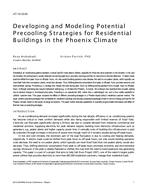Description
Residential air conditioning systems represent a critical load for many electric utilities, especially for those who serve customers in hot climates. In hot and dry climates, the cooling load is usually relatively low during night hours and early mornings and hits its maximum in the late afternoon. If electric loads could be shifted from peak hours to off-peak hours, not only would building operation costs decrease, the need to run peaker plants, which typically use more fossil fuels than non-peaker plants, would also decrease. Thus, shifting electricity consumption from peak to off-peak hours promotes economic and environmental savings. Precooling is a strategy that reduces the load during peak hours by shifting cooling operation from on-peak hours to off-peak hours. Although precooling may require mechanical cooling (e.g., in climates like Phoenix, Arizona), this cooling is less expensive than on-peak cooling due to demand charges or time-based price plans. Precooling is an operational shift, rather than a technological one, and is thus widely accessible to utilities’ customer base. This paper compares the effects of different precooling strategies in a Phoenix-based utility’s residential customer market. The paper presents precooling strategies that are feasible for residential buildings and discusses associated advantages of each in terms of energy and load for the Phoenix climate, based on the results of energy simulations. The paper further discusses capabilities of available programmable thermostats and effects of thermal mass on precooling strategies.
Product Details
- Published:
- 2015
- Number of Pages:
- 8
- Units of Measure:
- Dual
- File Size:
- 1 file , 500 KB
- Product Code(s):
- D-AT-15-C030
- Note:
- This product is unavailable in Russia, Belarus




